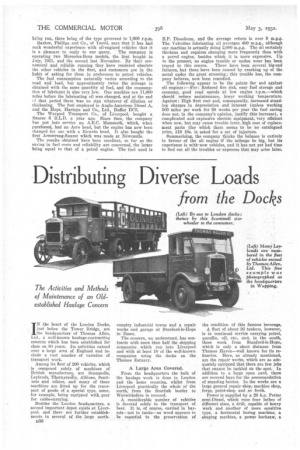Distributing Diverse Loads
Page 98

Page 99

If you've noticed an error in this article please click here to report it so we can fix it.
from the Docks
I N the heart of the London Docks, • just below the Tower Bridge, are the headquarters of Thomas Allen, Ltd., a well-known haulage-contracting concern which has been established for close on 80 years. Its activities extend over a large area of England and include a vast number of varieties of transport work.
Among its fleet of 200 vehicles, which is composed solely of machines of British manufacture, are Scammells, Leylands, Thornycrolts, Athlone, Sentinels end others, and many of these machines are fitted up for the transport of goods of a special type, some, for example, being equipped with, gear
for cable-carrying. •
Besides the London headquarters, a second important depot exists at Liverpool, and there are further establishments in several of the large north-.
country industrial towns and a repair works and garage at Stanford-le-Hope in Essex.
The concern, we understand, has contracts with more than half the shipping companies. which run into Liverpool and with at least 10 of the well-known companies using the docks on the Thames Estuary.
A Large Area Covered.
From the headquarters the bulk of the haulage work is done hi London and the home counties, whilst from Liverpool practically the whole of the north, from the Scottish border to Warwickshire is covered.
A considerable number of vehicles is devoted solely to the transport of beer. It is, of course, carried in barrels—not in tanks—as wood appears to be essential to the preservation of the condition of this famous beverage.
A fleet of about 36 tankers, however, is in continual service carrying petrol, paraffin, oil, etc., and, in the south, these work from Stanford-le-Hope,which is only a short distance from Thames Haven—well known for its refineries. Here, as already mentioned, are the repair works, which are so adequately equipped that there are few jobs that cannot be tackled on the spot. In addition to a large open yard, there are covered bays for the accommodation of standing lorries. In the works are a largo general repair shop, machine shop, . forge, paint-shop and so forth.
Power is supplied by a 20 h.p. Petter semi-Diesel, which runs four lathes of different sizes, a drill, capable of heavy work and another of more sensitive type, a horizontal boring machine, a
• shaping machine, a power hacksaw, a hand saw, two grinders, a magneto and dynamo tester, a large 50-volt dynamo and a powerful air-compressor for supplying the pneumatic hand-tools used in the fitting shop. A second compressor, for the inflation of tyres, is driven by a smaller Petter engine, which is also employed for starting-up the semiDiesel.
The magneto and dynamo tester is a simple and ingenious appliance which is worthy of a brief description, in view of the fact that it was built in the works and made up entirely of scrap
Parts. Mechanically it consists of a large steel disc mounted on the end of a horizontal shaft—driven by a belt— and a zecond shaft, also horizontal, running across the face of the disc. On the cross-shaft is a small friction wheel, free to slide and bearing against the disc. At one end of the cross-shaft is a coupling to which the armature of the inatrument to be tested is attached. By shifting the small wheel along its
shaft its speed can be varied from practically nothing to high r.p.m.—an ideal arrangement for the purpose in question. The switchboard is equipped with the usual instruments for indicating dynamo output, and with variable spark gaps for testing magnetos.
For a Special Job.
On inquiring the purpose of the band saw, we were informed that it had originally been installed for cutting out the wooden bolsters upon which the tanks of tankers are mounted and which, of course, must be shaped to the curvature of the bottoms of the tanks.
Tank and Boiler Work.
In the boiler and tank section of the works such jobs as retubing or completely reconditioning boilers are undertaken, and at the time of our visit, repiping operations were being carried out on a 2,500-gallon tanker.
It is no uncommon occurrence, we learned, for motors in this fleet to run from 80,000 to 100,000 miles before coming in for a complete overhaul, and an interesting detail is the treatment of cylinders according to the degree of wear found to exist. The rule, roughly, is this :—If the micrometer reveals no more than .010 in. of wear the cylinder in honed ; if there be more than .010 in, a rebore is made, and for wear in excess of .040 in. the cylinder block is sent away to be fitted with liners.
The boring and honing operations are carried out on the horizontal boring machine, which is also used for bearings after remetalling. It is capable a machining to within .001 in. Very few of the concern's vehicles are still running on solid tyres, for the gradual conversion of the whole fleet to pneumatics has beep in progress for a long time. Incidentally, we were told that a normal mileage for the giant pneumatics such as are fitted to the large tankers, is from 70,000 to 80,000.
















































































































































































